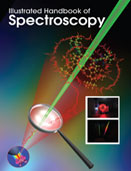Handbooks

Spectroscopy refers to a plethora of different techniques that employ radiation in order to obtain data on the structure and properties of matter, which is used for solving a wide variety of analytical problems. This handbook deals with measuring and interpreting spectra that arise from the interaction of electromagnetic radiation with matter. It is concerned with the absorption, emission, or scattering of electromagnetic radiation by atoms or molecules.
Spectroscopy is a scientific measurement technique. It measures light that is emitted, absorbed, or scattered by materials and can be used to study, identify and quantify those materials. In short, spectroscopy deals with measuring and interpreting spectra that arise from the interaction of electromagnetic radiation with matter. It is concerned with the absorption, emission, or scattering of electromagnetic radiation by atoms or molecules. Since its inception in the second half of the 19th century, the technique has developed to include every region of electromagnetic spectrum and every attainable atomic or molecular process.
Illustrated Handbook of Spectroscopy delivers a straightforward introduction to spectroscopy, showing what it can do and how it does it, together with a clear, integrated and objective account of the wealth of information that can be derived from spectra. Spectroscopic techniques are extremely sensitive. Single atoms and even different isotopes of the same atom can be detected among 1020 or more atoms of a different species. Trace amounts of pollutants or contaminants are often detected most effectively by spectroscopic techniques. Certain types of microwave, optical, and gamma-ray spectroscopy are capable of measuring infinitesimal frequency shifts in narrow spectroscopic lines. Because of this sensitivity, the most accurate physical measurements have been frequency measurements. Spectrometry also allows us to measure the velocities of celestial bodies, as well as distances on cosmological scales (to galaxies). When an object is moving, the wavelengths of light it gives off is shifted, either towards red (moving away) or towards blue (moving closer). When the emission/absorption lines are offset one way or the other, it is possible to tell how fast it is moving relative to us. Since the universe is expanding at an accelerating rate that is known, the redshift on distant galaxies can be translated via the hubble constant to a distance. This plays a part in measuring the size of the universe.
Illustrated Handbook of Spectroscopy presents a plethora of different techniques that employ radiation in order to obtain data on the structure and properties of matter, which is used for solving a wide variety of analytical problems.